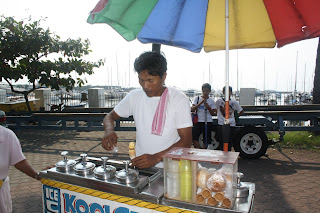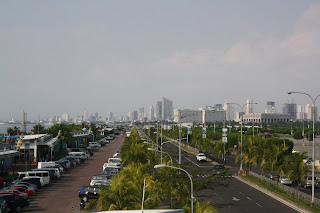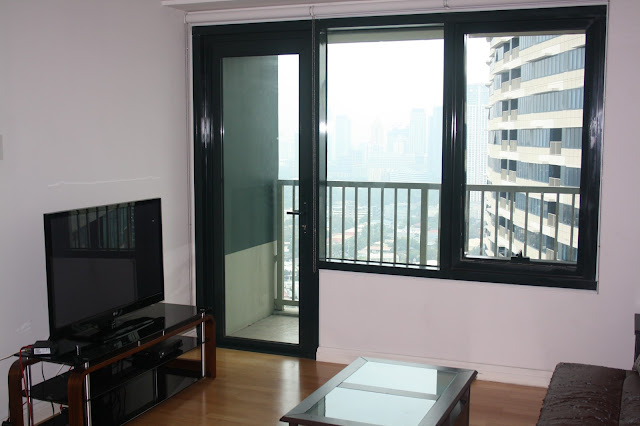For me, words like 'baywalk' conjure up romantic strolls along palm-tree lined promenades, listening to the sounds of waves crashing gently on the shore. Something like that anyway.
We decided to venture out to Manila Bay, which we can just see from our apartment window, last Sunday. We hailed a taxi to take us to Ocean Park. We weren't quite sure what Ocean Park was, but had seen it on a map and figured it was a landmark that a Manila taxi driver would know. It would also give us an opportunity to do the baywalk, ending up at the Manila Yacht Club with the option to carry on to Harbour Square.
Ocean Park turned out to be theme park with an aquarium, a bird-of-prey kingdom, a swimming pool etc. which was absolutely full of school groups. We decided to give it a miss, not wanting to battle with crowds of school children.
Instead we wandered into nearby Rizal Park and happened upon a lovely Chinese Garden. We spent some time there, just relaxing in the shade and taking in the sights and sounds before heading off to find Manila Bay's baywalk.
Wow. The first thing that hit us was the stench. It was not pleasant. It didn't smell of the sea at all. We peered over the wall and the beach was strewn with waste. I don't know for certain what this waste was, but it didn't look or smell good. But there were people swimming in the water. We decided not to join them.
We opted to walk down the busier part of the pavement, a little bit removed from the seafront.
It was fantastic. Various people offering foot massages, reflexology, Thai massage, manicures, pedicures. All on the pavement. Ice-cream vendors - some pedalling along an ice-cream cart with branded ice-cream, others pushing the traditional ice-cream carts with home-made ice cream. Snack vendors with massive bags of all sorts of snacks. Other snack vendors setting up to cook what I presume were meat sticks, shrimp balls etc. (we didn't see the food, just the setting up - it was just before lunch time).
The ice cream was delicious. I couldn't definitively identify the tastes, but I think there was some mango and chocolate in there. And all for 15 pesos - about 25p.
By the end of our walk down the bay we were pretty hot and bothered, so we hailed another cab and made our way to Mall of Asia. It really is amazing just how many malls there are here. And how many people go to the malls. Apparently it's because they are air conditioned, so they provide a welcome respite from the heat.
Mall of Asia is massive. It has hundreds of shops, eating establishments, cinemas and great views out over the bay.
We decided to venture out to Manila Bay, which we can just see from our apartment window, last Sunday. We hailed a taxi to take us to Ocean Park. We weren't quite sure what Ocean Park was, but had seen it on a map and figured it was a landmark that a Manila taxi driver would know. It would also give us an opportunity to do the baywalk, ending up at the Manila Yacht Club with the option to carry on to Harbour Square.
Ocean Park turned out to be theme park with an aquarium, a bird-of-prey kingdom, a swimming pool etc. which was absolutely full of school groups. We decided to give it a miss, not wanting to battle with crowds of school children.
Wow. The first thing that hit us was the stench. It was not pleasant. It didn't smell of the sea at all. We peered over the wall and the beach was strewn with waste. I don't know for certain what this waste was, but it didn't look or smell good. But there were people swimming in the water. We decided not to join them.
We opted to walk down the busier part of the pavement, a little bit removed from the seafront.
It was fantastic. Various people offering foot massages, reflexology, Thai massage, manicures, pedicures. All on the pavement. Ice-cream vendors - some pedalling along an ice-cream cart with branded ice-cream, others pushing the traditional ice-cream carts with home-made ice cream. Snack vendors with massive bags of all sorts of snacks. Other snack vendors setting up to cook what I presume were meat sticks, shrimp balls etc. (we didn't see the food, just the setting up - it was just before lunch time).
The ice cream was delicious. I couldn't definitively identify the tastes, but I think there was some mango and chocolate in there. And all for 15 pesos - about 25p.
By the end of our walk down the bay we were pretty hot and bothered, so we hailed another cab and made our way to Mall of Asia. It really is amazing just how many malls there are here. And how many people go to the malls. Apparently it's because they are air conditioned, so they provide a welcome respite from the heat.
Mall of Asia is massive. It has hundreds of shops, eating establishments, cinemas and great views out over the bay.
Another interesting day out in Manila. And it was so hot. Apparently it's just going to get hotter for the next few months. Summer here is March - May. And then the rainy season hits.


















